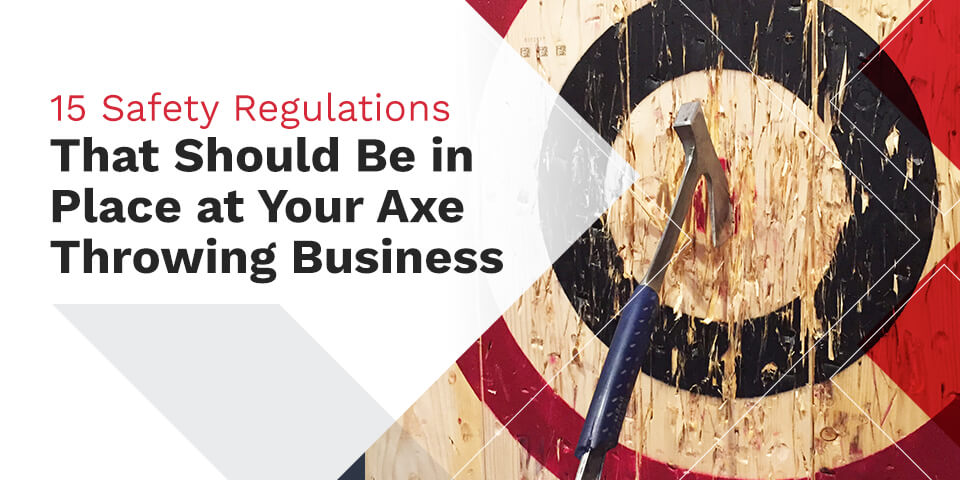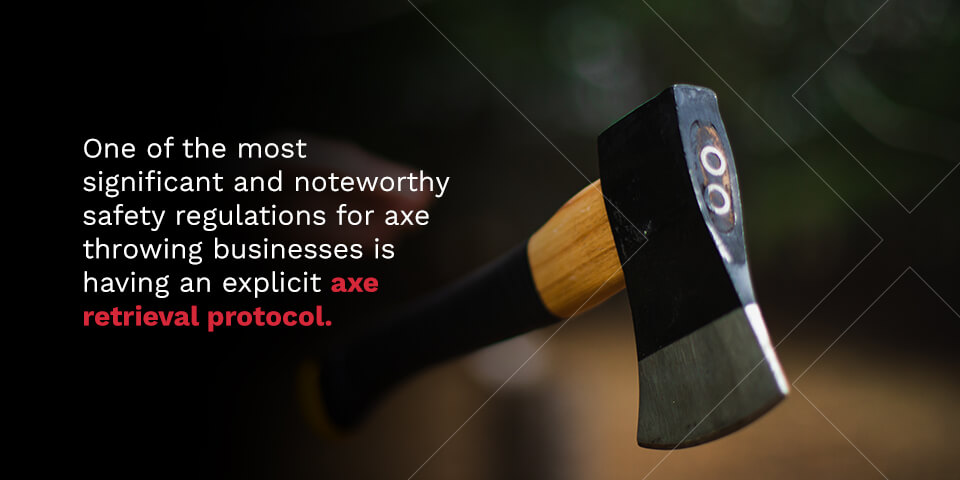
15 Safety Regulations That Should Be in Place at Your Axe Throwing Business
In recent years, axe throwing has become a go-to activity for people looking to have fun and blow off some steam. It has become a multi-million dollar industry with new axe throwing bars popping up all over the country.
The only way these businesses can keep their doors open is by having adequate safety regulations and protocols that keep attendees and employees safe. This is especially essential when your business serves drinks.
Learn more about the safety regulations that should be in place at your axe throwing business and the importance of protecting your operations.
Why Safety Regulations Are Important for Your Axe Throwing Business
It is crucial for axe throwing businesses to have and enforce safety regulations. This activity can be dangerous for everyone involved without the right guidelines in place. Some of the key reasons it’s important to have rules for your axe throwing enterprise include:
Preventing Injuries
Perhaps the most obvious reason for having safety regulations is to prevent injuries. Axe throwing can be dangerous. Business owners should prioritize the safety of attendees and employees above all else.
Many of your business’s visitors will be first-time axe throwers, meaning they will need the necessary education to avoid getting hurt or hurting someone else.
Proper regulations help protect your staff and comply with the Occupational Safety and Health Administration’s (OSHA) Recommended Practices for Safety and Health Programs.
Minimizing Property Damage
Safety regulations protect your attendees and workers, and they also help preserve your property. Throwing axes can create substantial damage to walls and floors, especially if people are not following the established rules.
Having the right setup and materials is essential for creating a space where axe throwing activities can take place without wrecking the surrounding areas — everything from the material of the target to the sharpness of the axes matters. Having the proper regulations in place can help you minimize damages to your physical business.
Enhancing Operations
Safety regulations can also keep operations organized and encourage attendees to keep coming back.
People like to do activities that feel structured while also being fun. They need to feel protected and like your staff is there to keep them safe. If they feel on edge while visiting your business, they are likely not to return. Safety regulations are the backbone of axe throwing businesses.
Avoiding Lawsuits
A huge reason to implement safety rules is to avoid lawsuits. When running a business around an activity that can be hazardous, there is always a potential for being sued.
Having strong safety guidelines in place can help avoid injuries and protect your business in the face of a lawsuit. It is also highly beneficial and necessary to have adequate insurance coverage from a reliable insurance company to further safeguard your operations.
15 Safety Regulations For Your Axe Throwing Business
When starting a new axe throwing business or refining your current practices, consider implementing these safety regulations:
1. Waivers
Your business should always require all participants to read and sign a waiver. Waivers inform your attendees about the risks associated with axe throwing and their responsibilities while participating in the activity. Having them review the waiver is a great way to introduce them to the other regulations they’ll need to follow.
Most importantly, the purpose of a waiver is to extend legal protections to your business in the event that someone tries to sue you. When participants sign, they agree that they cannot blame or sue your company in the event of an accident or mishap.
2. Safety Briefings
Before allowing attendees to start throwing axes, they should undergo an in-depth safety briefing that teaches them the protocol they will need to follow. People cannot follow rules they don’t know about. Your staff should go over every detail to ensure participants know exactly how to behave and what to do in case of an emergency.
Safety briefings keep everybody on the same page and are necessary for high-risk activities, especially for establishments that serve alcohol. Safety briefings can also help participants regulate each other and remind each other of the rules they need to follow.
3. Age Limits
While axe throwing is often largely an adult activity, it can be a family affair, as well. Having age restrictions is important for maintaining the safety of all participants and protecting your business against potential lawsuits.
Most businesses require axe throwers to be at least 12 or 16 years of age to participate. It’s best to require anyone under the age of 18 to have a legal guardian or parent accompany them and co-sign their waiver. All adult participants should bring valid identification such as their driver’s license to ensure compliance with age restrictions and disclaimers.
Younger children should not participate in axe throwing due to the nature of the activity.
4. Dress Code
Because axe throwing is a potentially dangerous physical activity, it is important that attendees and employees comply with a dress code. Make sure your business establishes rules regarding what to wear to keep everyone a little safer.
Encourage participants to wear closed-toe shoes. If they have long hair, ask that they tie it back. Ask them to avoid wearing restrictive items like dress shirts or multiple layers. Encourage them to wear simple outfits that are comfortable and offer good mobility. Some axe throwing businesses require everybody to wear pants rather than other bottoms like shorts or skirts to protect their legs, as well.
5. Food and Drink Rules
It’s common for axe throwing bars to serve food and drink, but it’s also beneficial to have finite rules in place regarding where people can eat and drink and where they cannot.
Having a dedicated space where people go to eat is a good practice for your business. This can reduce the risks of the following happening in the throwing areas:
- Slipping
- Losing grip on an ax
- Choking
Keeping food and drink in one space will keep the premises cleaner and help to avoid these safety threats.
6. Rules on Intoxication
When running an axe throwing business that serves alcohol, it is imperative that you have safety regulations in place for addressing intoxication.
It is not safe to allow attendees that have consumed too much alcohol to participate. This creates a dangerous environment for everybody, and your business should not tolerate it.
Make sure your employees are keeping a close eye on those who your bar serves. All participants must be coherent and attentive before throwing an axe. Be sure to let your attendees know that they can no longer partake in the activity if they are intoxicated, either upon arrival or while they are at your establishment.
7. Employee Supervision
Another important safety regulation for axe throwing businesses is having employee supervision at all times. Offer your team the proper training to proactively enforce safety rules. Have regular safety and training meetings to refresh their memories.
As a business that revolves around a dangerous activity like throwing axes, it is necessary to have your team oversee everything that’s going on. Like lifeguards at a beach or pool, your employees are responsible for ensuring all participants are following the right protocols.
There are a lot of rules to follow and it is inevitable that someone forgets one here or there. That’s why your employees should be there to offer reminders and keep everything in working order. Try to operate with a full staff to ensure every throwing area has multiple eyes on it.
8. Axe and Target Maintenance
Maintaining your equipment is essential to keeping your business safe for both your workers and participants. There are a few different things to be mindful of as a business owner, including:
- Axe handles: Axes with wooden handles are generally a better option than those with rubber handles. The rubber can cause the axe to bounce off the wall or floor upon impact, creating additional safety concerns.
- Edge sharpness: Axes do not need razor-sharp blades to effectively penetrate the target. It is best that the edge is just slightly dulled so throwers do not accidentally cut themselves while handling the axe.
- Target material: The ideal target for axe throwing is made of end-grain wood because it is soft, making it easier for axes to stick and less likely to bounce. A straight grain also prevents the axe from splitting the target.
- Border materials: It is best for axe throwing businesses to have no-bounce borders around their targets to avoid the safety hazard of axes rebounding back toward participants.
9. Rules for Axe Handling
There should also be rules for how to handle the axes. Be sure to walk visitors through how to properly hold the axe, avoiding the blade entirely. Explain the importance of never trying to catch or stop an axe if it bounces.
To further ensure the safety of employees and participants, we recommend requiring participants to receive and hand off axes to employees only, not other attendees. Doing so will help avoid unnecessary accidents and allows your team to manage throwers better.
Your team should discuss axe handling in your safety brief and while attendees are participating. You can also post signs demonstrating axe handling instructions.
10. Axe Throwing Instruction
Your business should educate participants on how to properly throw an axe, in addition to the safety brief and handling instructions.
For many visitors, this will be the first axe they have ever thrown. Teach them how to throw without injuring themselves or causing a safety risk to the people around them.
Before allowing participants to begin, it can be very beneficial for your team to share tips and guide throwers through a few practice rounds. The more equipped attendees are, the safer the activity is for everyone. Again, signs with images on proper throwing techniques can be helpful to post.
11. Axe Retrieval Guidelines
One of the most significant and noteworthy safety regulations for axe throwing businesses is having an explicit axe retrieval protocol. No one should ever be in the lanes when someone else is throwing.
Having structure and organization for each lane is essential for keeping everyone safe when collecting the axes. If someone is retrieving their ax while another person is throwing, this could become a very dangerous situation quickly.
Your employees should instruct participants on when to throw and when to retrieve. It is of the utmost importance that axes are at rest when attendees or workers walk down the lanes.
12. Designated Areas
Every axe throwing business should have designated throwing lanes and safety areas. Separate those who are actively participating from those waiting for their turn or spectating.
Each lane should only have one participant at a time. It can be helpful to have an employee monitor both areas. This can keep lanes clear for throwers and allow for better regulation.
Having designated areas can be helpful in ensuring participants are in the right space and that all axes stay in their respective locations. It can be a safety risk having axes in the designated safety or eating areas.
13. Rules Against Outside Axes
A safety regulation your axe throwing business may have overlooked is prohibiting the use of outside axes.
There are professional axe throwers that participate in organizations like the World Axe Throwing League that use special competition axes for their tournaments. Occasionally, experienced attendees will want to bring their own axe with them to your business, but you shouldn’t allow it. Let people know you don’t let outside axes in when they are making reservations.
The axes at your establishment work well with your targets. Outside axes may behave differently once they hit the target, and this could cause an additional safety hazard. Again, it is best to keep all equipment in its designated spaces, and allowing participants to bring their own axe could cause many safety concerns.
14. Rules for One Axe Per Lane
Your business should only allow a certain number of axes per lane, typically just one. This helps instructors regulate participants better and keep track of everything that is going on in the throwing areas. Combine this rule with retrieval guidelines to help keep everyone safe.
15. Zero Tolerance for Horseplay
Consider implementing a zero-tolerance policy regarding horseplay for your axe throwing business. While you want your business to be an exciting place for visitors, roughhousing can be a serious safety concern and ruin the fun for everyone, even if they have private lanes or a private party room.
Keep your workers and attendees safer by prohibiting horseplay in all forms, from pretending to throw an axe somewhere other than the target to interfering with a thrower on their turn. Rowdy behavior can be distracting and ultimately dangerous. This is why it is best to forbid it on the premises of your axe throwing business.
Protect Your Axe Throwing Business
Having the right safety regulations is essential for protecting your axe throwing business. You should prioritize the well-being of your employees and customers while safeguarding yourself with the right axe throwing business liability insurance coverage.
XINSURANCE may be able to help you stay protected against potential lawsuits with agritainment insurance. We offer customized options for coverage, limits, and premiums through our all-in-one approach. We aim to give policyholders true peace of mind with a free policy review and a free quote.
Do you have questions regarding axe throwing liability insurance? Contact XINSURANCE to learn more today!

Rick J. Lindsey hails from Salt Lake City, Utah. He began working in the mailroom of his father’s Salt Lake City insurance firm, getting his introduction to the business that became his lifelong career. Rick J. Lindsey quickly rose through the ranks while working in nearly every imaginable insurance industry job. As an entrepreneur, specialty lines underwriter, claims specialist, risk manager, and a licensed surplus lines broker, Rick J. Lindsey is highly skilled in all levels of leadership and execution. As he progressed on his career path, Rick J. Lindsey discovered an urgent need for insurers willing to write policies for high-risk individuals and businesses. He was frequently frustrated that he could not provide the liability protection these entities desperately needed to safeguard their assets. He also formed the belief that insurance companies acted too quickly to settle frivolous claims. Rick J. Lindsey decided to try a different approach. He started an insurance company and became the newly formed entity’s CEO. This opportunity has enabled Rick J. Lindsey to fill a void in the market and provide a valuable service to businesses, individuals, and insurance agents who write high-risk business. XINSURANCE also specializes in helping individuals and businesses who live a lifestyle or participate in activities that make them difficult for traditional carriers to insure. If you’ve been denied, non-renewed, or canceled coverage, don’t give up quite yet. Chances are XINSURANCE can help.





